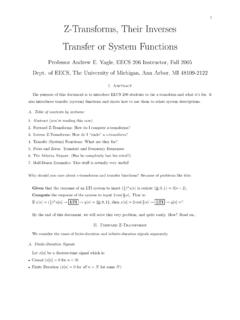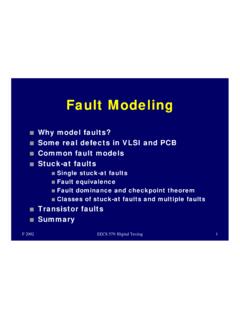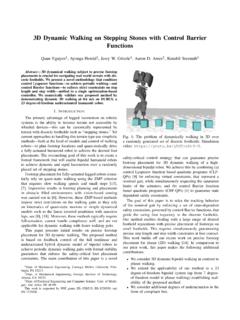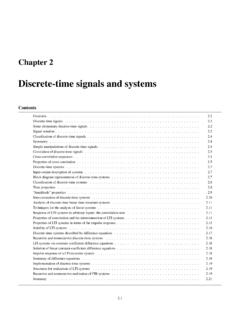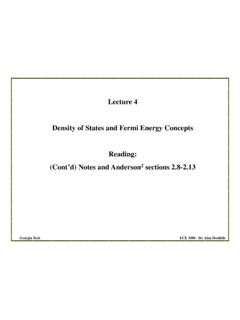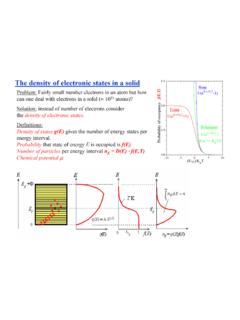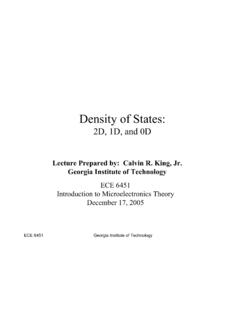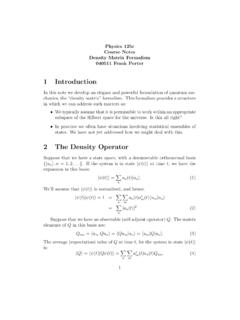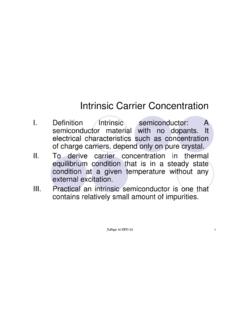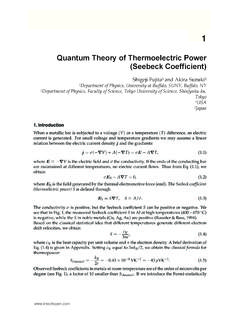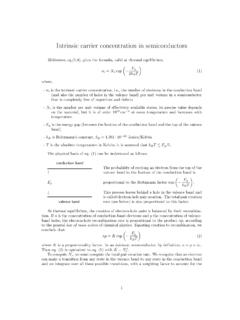Transcription of Density of States Derivation - University of Michigan
1 Density of States Derivation The Density of States gives the number of allowed electron (or hole) States per volume at a given energy. It can be derived from basic quantum mechanics. Electron Wavefunction The position of an electron is described by a wavefunction zyx,, . The probability of finding the electron at a specific point (x,y,z) is given by 2,,zyx , where total probability dxdydzzyxspaceall 2,, is normalized to one. Particle in a Box The electrons at the bottom of a conduction band (and holes at the top of the valence band) behave approximately like free particles (with an effective mass) trapped in a box.
2 We will consider here conduction band electrons, but the result for holes is similar. For our parabolic conduction band: 22*2ckEEm For electrons in a rectangular volume Lx by Ly by Lz with an infinite confining potential ((U(x,y,z)=0 inside the box and outside), the electron wavefunction must go to zero on the boundaries, and takes the form of a harmonic function within the region. The wavefunction solution is: , ,sinsinsinxyzx y zk xk yk z (1) andxk,yk, and zkare the wavevectors for an electron in the x, y, and z directions.)
3 The real wavefunction in a solid is more complex and periodic (with the crystal lattice), but this is a good approximation for the parabolic regions near the band edges. First 4 particle in a box wavefunctions across the x direction. Orthogonal directions are analogous. Enforcing the boundary conditions: At x, y, or z = 0, the sine functions go to zero. At the opposite boundaries of the rectangular region, 0sin xxLk, 0sin yyLk, and 0sin zzLkfor the x, y, and z directions. The allowed wavevectors satisfy: xxxk Ln ,yyyk Ln ,zzzk Ln , forzyxnnn,, integers (2) K Space The allowed States can be plotted as a grid of points in k space, a 3-D visualization of the directions of electron wavevectors.
4 Allowed States are separated by ,,/x y zL in the 3 directions in k space. The k space volume taken up by each allowed state is 3/xyzL L L . The reciprocal is the state Density in k space (# of States per volume in k space), 3/V where V is the volume of the semiconductor (in real space). The number of States available for a given magnitude of wavevector |k| is found by constructing a spherical shell of radius |k| and thickness dk. The volume of this spherical shell in k space is dkk24 . Allowed wavevector States in k space form a lattice.
5 A spherical shell gives the number of allowed States at a specific radius |k|. The number of k States within the spherical shell, g(k)dk, is (approximately) the k space volume times the k space state Density : 23( )4Vg k dkkdk (3) Each k state can hold 2 electrons (of opposite spins), so the number of electron States is: 23( )8Vg k dkkdk (4a) Finally, there is a relatively subtle issue. Wavefunctions that differ only in sign are indistinguishable. Hence we should count only the positive nx, ny, nz States to avoid multiply counting the same quantum state.
6 Thus, we divide (4a) by 1/8 to get the result: 2232()VVkg k dkkdkdk (4b) This is an expression for the number of unique electron States available at a given |k| over a range dk. We need an expression in terms of energy rather than wavevector k. We proceed from the relationships between wavevector, momentum p, and energy E: kp ,*22/mpE *222mkE (5) with *m as the effective mass. Rewriting, and noting that the energy of carriers in the conduction band is given with respect to the conduction band edge energy Ec: *222cE Emk (6) Differentiating: 2*22 dEmkdk (7a) Combining (6) and (7a): **222*2**2222ccm dEm dEm dEdkkkm E Em dEm E E (7b) Plugging (6) and (7) into (4b).
7 2*2**2*1/ 22*1/ 2**23()22/22ccccVkm dEg k dkm E EVm E Em dEm E EVmm E EdE (8) Dividing through by V, the number of electron States in the conduction band per unit volume over an energy range dE is: 1/ 2**232()cmm E Eg E dEdE (9) This is equivalent to the Density of the States given without Derivation in the textbook. 3-D Density of States , which are filled in order of increasing energy. Dimensionality The Derivation above is for a 3 dimensional semiconductor volume. What happens if the semiconductor region is very thin and effectively 2 dimensional?
8 Confining the electron in the x-y plane, the wavevector z component kz =0. The allowed States in k space becomes a 2 dimensional lattice of kx and ky values, spaced ,/xyL apart. The 2-D k space area taken up by each state is 2/xyLL . The number of States per area in k space is 2/A with A as the real-space area of the thin semiconductor. The number of States available at a given |k| is found using an annular region of radius |k| and thickness dk rather than the spherical shell from the 3-D case. There is a factor of due to the equivalent nature of the +/- States (just as there was 1/8 in the 3D case).
9 The area is kdk . The number of k space States is: 2( )2Ag k dkkdk 2 spin States 4 equivalent States = Akdk (10) Converting to energy using (7b): ()Ag k dkkdk 1/ 2*2*1/ 2*22ccAm E EmdEm E E (11) Cleaning up and dividing through by area, the Density of States per area at an energy E over a range dE is: 2*)( dEmdEEg (12) Unlike the 3-D case, this expression is independent of energy E! In a real structure (which is not perfectly 2-D), there are finite energy ranges over which the energy independence holds (the Derivation holds for each single, well separated possible value of kz).
10 The resulting Density of States for a quantum well is a staircase, as below in red. Further restriction of the semiconductor dimensionality to 1-D (quantum wire) and 0-D (quantum dot) results in more and more confined Density of States functions. Density of States for 0-D through 3-D regions. Low dimensional and confining nanostructures have lots of applications controlling carriers in semiconductor devices.

